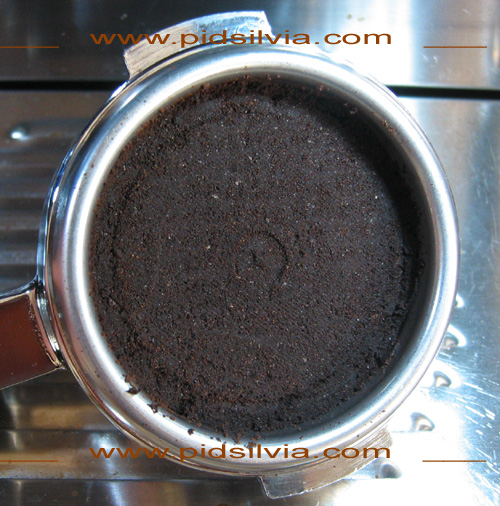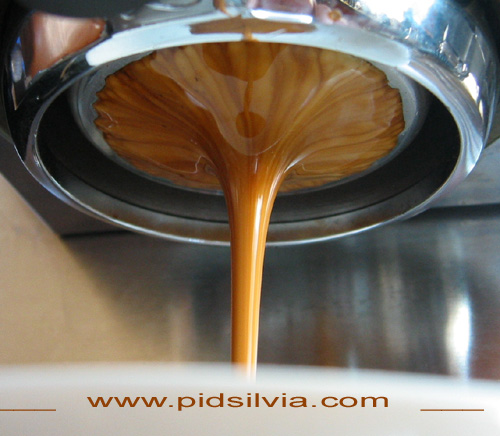![]()
| HOME | How to Order |
|
Dosing Technique For Silvia - Long.- Back
Making
espresso simple
Making espresso is very mysterious; the outcome is influenced by hundreds of direct and indirect variables. As a result, many books, machines, accessories and recommendations are being produced to help create the “perfect” shot, far more then for making a decent hard-boiled egg.
So here I will add my own recommendation to the pile--yes, one more. I will try to be concise, without much explanation of why this should work.
First, since there are so many variables, we need to prioritize the importance of these variables so we can come up with a few simple, but critical rules. We need to find rules that will optimize the shot that can be obtained from any type of bean blend and any degree of roast. Certainly fresher coffee is the best to work with and strict temperature control is important as is the pressure at which the coffee is extracted from the beans, but if the dose and grind are wrong, fixing the temperature and the pressure will be of little help. Conversely, if we can find the dose and grind that works, some temperature variation and pressure variation will not significantly detract from the coffee produced.
In
this paper, all references are to a double shot basket., but the technique works
for a single shot basket as well.
In
order to achieve high efficiency in extraction, to reduce variations and narrow
the influence of the many other variables, the coffee puck must touch the shower
screen with sufficient pressure during the brewing cycle. The degree of the imprint of the screen after the soaking
of the coffee during the extraction is a measure of whether
there was sufficient pressure. Too
much pressure from the screen will cause poor filtering through the puck and
will lock the puck tight to the basket. If
the coffee isn’t pressed against the screen it will not provide a consistent
enough filter.
So
here are the two basic rules:
The more strictly you follow the two rules below, the less influential all the other hundreds of variables.
Rule # 1 - Uniform Distribution. Uniform coffee distribution in the basket must be maintained at all times through the brew cycle.
Rule # 2 - Correct Screen Pressure. Proper dosing will result in correct pressure from the screen which will helps stabilize the puck during brew and will provide a single reference point to maximize the consistency of the brew. To achieve correct screen pressure you must not be under dosing. In mechanical terms, you need to assure that before and during the extraction, the coffee puck is pressed against the screen ( initially just touching the screen so that when the water is introduced into the puck, the coffee will expand or swell and provide sufficient pressure at the screen) If you under dose, you will need to grind the coffee too fine to produce a proper extraction and this will result in poor taste, screen sticking and other problems.
The screen pressure rule above is less important if you use a triple basket and get above a 2.5 dose as the size of the “filter” provided by the coffee reduces the need for the screen pressure to maintain a stable puck. ( and you will lose some efficiency in extraction )
The more compaction you apply to the coffee puck before the brew by tamping, meaning, the more compressed the puck is before the brew, the more difficult it is to achieve uniform extraction. This is because there is less cushion in the structure, less free play to compensate for for uneven pressure within the puck.
Given these rules, all we need to know is:
How
much coffee to use in order to comply with Rule # 2
What size of grind to use in order to control the brew to produce about 50ml of coffee with crema in around the 25 seconds.
So,
all you need to do is adjust the size of the grind for the weight of
coffee you put in the portafilter (usually, between 15g and 17g of whole
beans) to get the double shot of about 50ml of coffee and crema in 25
seconds.
Step 1.
The
correct amount of coffee can be consistently measured by volume in the basket by
spreading coffee evenly and scraping the top (no pressing).
Each type of coffee and roast may need a small adjustment. (In most cases
the adjustment is to reduce the amount, so a convex edge can be used to scrape
the top,) or simply use a scale and
measure the coffee by weight,--it is a less messy
process.
-
Until you can get the amount of coffee and size of grind right, try to
maintain consistent pressure and water temperature at the puck.
-
After the coffee is spread evenly in the basket, Start with very light
tamping to even off the top of the puck—up to a maximum of 1 kilo or 2 LB and
brew with your usual grind coarseness
- If the puck has no screen imprint after the brew, meaning too little coffee (it will most likely be very wet on top with large portion of the puck sticking in the basket when you shake out the protafilter after brewing), increase the amount of coffee and if close (+/- 5) to the 25 second mark, keep the grind the same.
-
If puck has a screen imprint and the puck sticks solidly in the basket,
decrease the amount of coffee just slightly to reduce the depth of the imprint
to the point where the puck comes cleanly out of the basket.
This is your baseline. Now
move on to the grind.
Step
2.
Adjust
the grind size to achieve the 25 seconds and 50ml of coffee with crema in the
glass. Note that the weight of a
brewed double espresso is about 32
±4
grams. The rest of what is
in the glass is foam and solids.
If
you adjust only the grind size, without the puck touching the screen, you are
losing your reference point and you can’t get the benefit of these rules.
So now, if everything has been done correctly, all you have to do is to stop the brew at the right time, before it becomes too harsh and bitter because different coffee has different amount of gas within it. for example, older coffee will not produce the full 50ml of coffee if you allow a 25 second extraction—bitter taste will start coming through much sooner.
END
Note
1: You can produce a good shot with
under dosing (and no screen imprint), but with many types of coffee this may
require grinding more and more fine—and if the grind gets too fine, you reduce
crema and, in combination with too firm a tamp, the puck could even
stick to the screen (contrary to what would appear to be common sense,
the puck is more likely to stick to the screen with under dosing and firm tamp.
Note 2:
If the coffee puck sticks to the basket so that you need a knock box (and
maybe a hammer) to get it out (in most cases, it will be very dry at the top),
you did not get a good, full extraction. The incomplete extraction resulted from
the excess coffee expanding or swelling and creating a plug,; the emulsification of the oils
in the coffee was incomplete. Or insufficiently hot water at the puck or
insufficient water passing through the puck.
Note
3: If the coffee puck falls out in
pieces, with a portion of the puck remaining in the basket, you might have
gotten a sufficient extraction of the coffee you used by compensating with a
finer grind, but you had too little coffee without sufficient pressure at the
screen. The fall-apart puck is the
result.
Note
4: If the coffee puck
sticks to the screen, you had too little coffee and you used a hard firm
tamping.
|
|

The imprint will look slightly different with different coffee. |
|
What should you look for other than color and time.
|

|
If you still are having problems and you want to give up, then use the larger basket Rancilio 18+ grams basket (40-100-103). but you will have to use more coffee, about at least 18 grams and more.
For a discussion of the perfect Italian espresso by an industry trade group, see the Instituto Nationale Espresso Italiano (PDF) (or PDF here Instituto Nationale Espresso Italiano).
If you still having problems, please check that you don't have too dense clumps.
|
|